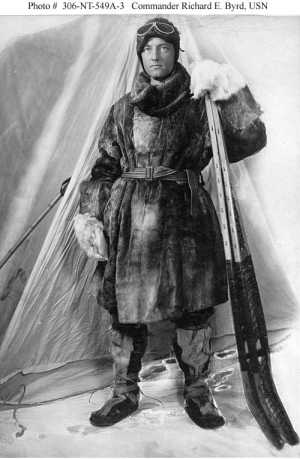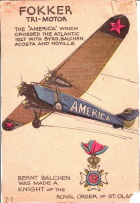Richard Byrd
First to Fly over South Pole in 1929
Claimed to be First to Fly over North Pole in 1926
By Stephen Sherman, Dec. 2007. Updated July 21, 2011.
On May 10, 1926, the Boston Post reported that Commander Richard Evelyn Byrd and his mechanic, Floyd Bennett, had flown over the North Pole. In recent years, that claim has come into doubt. Erased sextant sightings in his original logs and the maximum speed of the Fokker apparently have settled the matter, to Byrd's discredit. The modern consensus is that he flew about 80% of the way to the Pole, turned back, and then falsified his report.
The following information is summarized from the contemporary account in the Boston Post newspaper, essentially Byrd's unchallenged version. The headlines, shown below, speak for themselves. I am presenting this account for historical curiosity, and aside from the minor matter of not reaching the Pole, the flight was a great achievement of the time.
The newspaper account itself includes contradictions, surprise at his "amazing" speed, and a sole reliance on Commander Byrd's word. All these, at least in retrospect, provide reasons for skepticism. I have added a few comments of my own after the contemporary newspaper version.
Commander Byrd Flies to Pole and Back Again --- Does 1500 Miles in 15 1/2 Hours
Lieutenant Commander Richard Byrd, of the United States Navy, conquered the North Pole by air, winning his aerial race to the top of the world in the airplane Josephine Ford,the first air conquest of the North Pole, according to a Central news message received last night from Oslo.
The dispatch says that Commander Byrd, who left Kings bay, Spitsbergen, in his Fokker exploration plane at 2 o'clock this morning has returned there this evening, after a flight of fifteen and a half hours. The natives were amazed at Byrd's sudden and early return for they believed his hazardous journey would consume at least twenty-four hours.
The Fokker, which was named for the grand-daughter of Henry Ford, was supplied with food sufficient for a flight of 1400 miles, a distance that would permit the intrepid airman to reach his goal and return to the seat of operations at Kings Bay.
Byrd froze his fingers and nose in his remarkable flight in making observations at the Pole. His pilot was Floyd Bennett, chief petty officer, U.S. Navy.
AMAZED BY SPEED
Byrd, in 15 1/2 Hours, Covers Territory Admiral Peary Struggled Eight Months to Cross.
Commander Byrd, in flying to the North Pole from Kings Bay and back today in 15 and 30 minutes, demonstrated that wings could do in less than a day what Admiral Peary, discoverer of the North Pole, consumed eight months in negotiating by dog sled. This also made Byrd's the first of nine expeditions attempting the feat to reach the North Pole this year.
His giant three-motored airplane carried him safely over wastes which Amundsen last year pronounced unsafe for airplane flights, and the distance travelled, roughly 1600 miles, was equal to more than a month's mushing in the Arctic under the most ideal conditions for dog teams.
The flight and return of Commander Byrd, recounted by wireless, were far different, both in the act and the transmission of news, than Peary's departure in 1908.
The report that Byrd, who last year accompanied MacMillan into the North, has actaully reached the pole before returning to his base, was received with surprise here, as the announced plans for his first flight called only for negotiating the 400 miles to Peary Land and return, a total of 800 miles.
Amazing Speed
This in itself is considered a daring feat, because of the paucity of landing places on the jagged Arctic ice plains, the flight of at least 1600 miles in a round-trip hop to the pole rivalled the most optimistic hopes of observers of this flight.
The sealed scientific instruments and gauges carried by the plane of Commander Byrd are expected to eradicate much of the detail heretofore necessary in establishing the authenticity of travel claims.
Distance Travelled
The newspaper account is all over the place on this point, citing in different places 1200 miles, 1400 miles, 1500, and 1600 miles. I do not know if these discrepancies were Byrd's or the newspaper's own. In any case, the distance from Kings Bay (modern Ny-Alesund), Spitsbergen to the North Pole is 760 statute miles, based on its latitude of 78 degrees 55 minutes. Thus a round-trip, straight-line flight from kings Bay to the North Pole is 1520 miles, which is nearly the largest of the numbers cited. Briefly, this distance would have been the extreme maximum of the Fokker's cruising radius, an unlikely, but not theoretically impossible, achievement.
Speed
To cover 1520 miles in 15 and 1/2 hours would have required an average speed of 100 MPH. This is right at the Fokker's maximum cruising speed. To achieve this, Byrd would have had to not encounter any headwinds at all, and to not had to slow his speed for any reason for any time. Highly unlikely.
Instruments
As for the "sealed instruments" mentioned, that's pure hogwash. As noted in the Wikipedia article linked above, Byrd's claim was only validated by his own falsified sextant readings, and the erased original readings were still legible. There were no "sealed" flight recorders or other instruments in the 1920s that could have provided any tamper-proof evidence of the airplane's journey.




